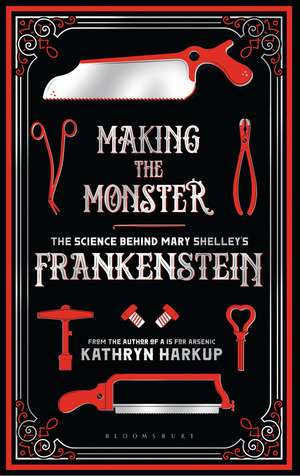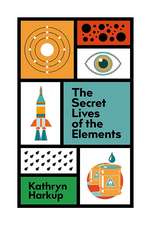Making the Monster: The Science Behind Mary Shelley's Frankenstein
Autor Kathryn Harkupen Limba Engleză Paperback – 18 sep 2019
Preț: 52.02 lei
Preț vechi: 111.91 lei
-54% Nou
Puncte Express: 78
Preț estimativ în valută:
9.95€ • 10.39$ • 8.24£
9.95€ • 10.39$ • 8.24£
Carte tipărită la comandă
Livrare economică 05-19 aprilie
Livrare express 01-07 martie pentru 77.33 lei
Preluare comenzi: 021 569.72.76
Specificații
ISBN-13: 9781472933768
ISBN-10: 1472933761
Pagini: 304
Ilustrații: 11 black and white illustrations
Dimensiuni: 129 x 198 x 22 mm
Greutate: 0.18 kg
Editura: Bloomsbury Publishing
Colecția Bloomsbury Sigma
Locul publicării:London, United Kingdom
ISBN-10: 1472933761
Pagini: 304
Ilustrații: 11 black and white illustrations
Dimensiuni: 129 x 198 x 22 mm
Greutate: 0.18 kg
Editura: Bloomsbury Publishing
Colecția Bloomsbury Sigma
Locul publicării:London, United Kingdom
Caracteristici
Explores the influence of Frankenstein-era science on cutting edge research and achievements in creating the building blocks of life
Notă biografică
Kathryn Harkup is a chemist and author. Kathryn completed a doctorate on her favourite chemicals, phosphines, and went on to further postdoctoral research before realising that talking, writing and demonstrating science appealed a bit more than hours slaving over a hot fume-hood. She wrote a monthly poison blog for the Guardian and gives regular public talks on the disgusting and dangerous side of science. Kathryn's first book was the international best-seller A is for Arsenic, which was shortlisted for a Mystery Readers International Macavity Award and a BMA Book Award, and she is also the author of Death by Shakespeare: Snakebites, Stabbings and Broken Hearts and Superspy Science: Science, Death and Tech in the World of James Bond.@RotwangsRobot
Cuprins
Preface PART 1: CONCEPTIONChapter 1: EnlightenmentChapter 2: DevelopmentChapter 3: ElopementChapter 4: NascentPART 2: CREATIONChapter 5: EducationChapter 6: InspirationChapter 7: CollectionChapter 8: PreservationChapter 9: ConstructionChapter 10: ElectrificationChapter 11: ReanimationPART 3: BIRTHChapter 12: LifeChapter 13: DeathEpilogueAppendix: Timeline of EventsBibliographyAcknowledgementsIndex
Recenzii
Lucidly illuminates Shelley's investment in the rapidly expanding knowledge of chemistry, biology and electricity of her times, and reminds us of how Frankenstein helped inspire technological developments, such as the pacemaker.
Making the Monster reassembles the intellectual toolkit Shelley had at her disposal ... everything she could have known about alchemy, spontaneous generation, phlogiston, physical decomposition, anatomy, transplant surgery, galvanism and human reanimation, digested for the 21st-century reader.
An engaging account of the facts and fears of the 19th century that lay behind the composition of Mark Shelley's Frankenstein. A telling reminder that although science has moved on, fears about what it might soon do have scarcely changed.
A fascinating and educational journey through the shadowy twists and turns of medical history. The odours of the dissection rooms and the sounds of the public executions are brought to life just as vividly as the monster himself.
Making the Monster reassembles the intellectual toolkit Shelley had at her disposal ... everything she could have known about alchemy, spontaneous generation, phlogiston, physical decomposition, anatomy, transplant surgery, galvanism and human reanimation, digested for the 21st-century reader.
An engaging account of the facts and fears of the 19th century that lay behind the composition of Mark Shelley's Frankenstein. A telling reminder that although science has moved on, fears about what it might soon do have scarcely changed.
A fascinating and educational journey through the shadowy twists and turns of medical history. The odours of the dissection rooms and the sounds of the public executions are brought to life just as vividly as the monster himself.










